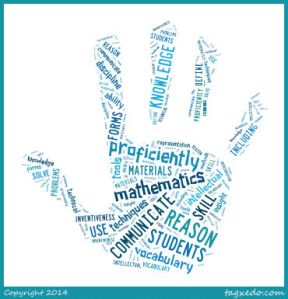Word Clouds
With just a simple paragraph about how students should be learning math from the Connected Math Program website, a visual learning word cloud tool has transformed this important paragraph into something that is truly meaningful and a gorgeous work of art. Through the use of Tagxedo at http://www.tagxedo.com/, the eye is drawn to the essential components of learning mathematics. I love idea presented in “108 Ways to Use a Word Cloud” which suggests taking my lesson plans, or even the course objectives, and using Tagxedo to share with students at the beginning of the year, or even at the start of a unit. The words used most often appear larger, drawing attention to what types of words the students will encounter the most frequently. If something like this was required to be in my students’ math binders, maybe even attached to activity handouts and assessments, almost like a unit icon, it would be a quick, but efficient reminder of what students are expected to know.
Mind Mapping
Through a simple mind map, students will be able have yet another example of a visual learning tool that will help them see what will be expected of them in the lesson. In this case, during the first week of school, I expect my Algebra I students will need to be review the Order of Operations. After viewing and discussing a quick power point (the top level of the mind map), students will partner up and play a quick game together (the second level of the mind map). This will be guided practice as they will have classmates and a teacher to help with any questions. Finally, the lowest level of the mind map shows what will be expected along the lines of independent practice. I used bubbl.us for this mind map, and you can find this order of operations mind map at https://bubbl.us/?h=2157b7/43c636/21Nj7TSVlqnN2&r=809494827.
QR Codes
WOW! I never really understood what these things were! I mean… I’ve seen them around of course, but it was always a great mystery to me. The code above should take the user directly to my school’s website which is located at http://www.marlette.k12.mi.us
Infographics
This is just a simple way to get information out to students and parents that is user-friendly. A ton of complicated information can be put into a format that just makes things a little easier for everyone. The screenshot above could be used during the first week of classes as I am trying to direct students and parents to my classroom “face”, directing them to what can be found on my site and where.
Face of the Classroom Connection
I chose to include the word cloud on my Weebly site, just because it such a powerful image for students and parents to see right away. You can view the word cloud at http://bgeorgeteacher.weebly.com/math-7.html, and I continue to think that using a word cloud such as this with the unit objectives would be a fantastic way to get students thinking about what they are supposed to be learning!
ISTE Standards
1) Facilitate and inspire student learning and creativity. There are so many opportunities through the mind maps and word clouds to encourage students to think of math in a whole new way.
2) Design and develop digital age learning experiences and assessments. Every one of these visual learning tools gives a digital connection to the math content.
3) Model digital age work and learning. As I use the mind maps, word clouds, QR codes, and infographics on my Weebly site, students are seeing an appropriate model of how to use these tools.
4) Promote and model digital citizenship and responsibility. Again, as I use the various visual learning tools, students are able to see clear examples of how to use the digital tools responsibly.
5) Engage in professional growth and leadership. As an instructor, using these visual learning tools makes me stand out as a leader through the use of creative applications used for student growth.
CITW Tools
1) Setting objectives/providing feedback – This could easily be demonstrated through the world cloud tool.
2) Reinforcing effort/providing recognition – As students are asked to create their own visual learning tools, this will allow their work to be recognized.
3) Cooperative learning – Students could easily work together to create a viable visual learning tool to share with classmates.
4) Cues/questions/advance organizers – The mind maps are excellent examples of organizers that will help students to organize their ideas.




Great use of the infographic!! I couldn’t think of what I would use it for, but that is perfect! Thanks for sharing!
I had a tough time wrapping my head around what an “infographic” even was…so this part of the assignment was a bit challenging. Glad I could be of some help!